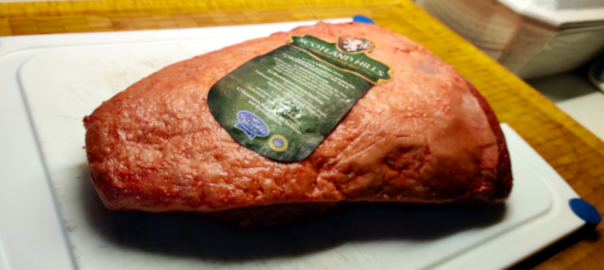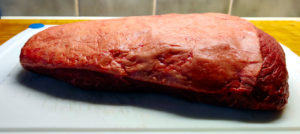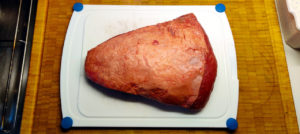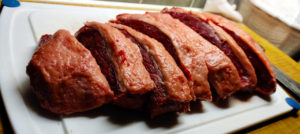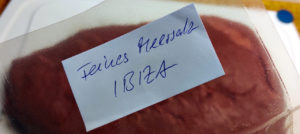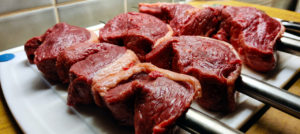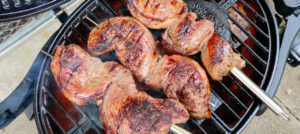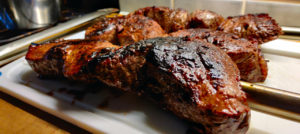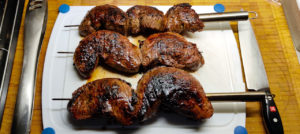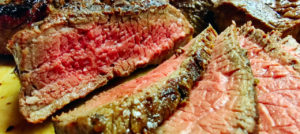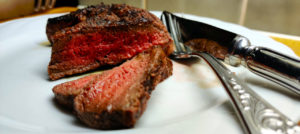In Germany and Austria, the piece of beef that is supposed to be the subject of today has a long tradition – the Tafelspitz. This is the tendon-free, tapering tip of the tail – basically the hip cap of a cow. At the meat counter you can easily recognize this piece by its triangular shape, where the thickness of the fat cover often varies. Due to my positive experiences I have decided to use heifer meat from SCOTLAND HILLS for this contribution as well.
Even back then – when I was still making my grandfather’s butcher’s shop “unsafe” – one thing was made clear to me – “Tafelspitz must cook or braise for many hours – otherwise it is much too firm to eat”. So, the classic Tafelspitz – the Austrians declare this recipe technically for themselves – has to simmer in broth for many hours before it can be enjoyed in slices with apple horseradish (the Austrian variant of the matching German horseradish sauce), root vegetables and new potatoes. By the way, the boiled beef also tastes delicious cold – “shreds” of it in horseradish cream with diced mustard cucumbers, parsley and ahhh…but that’s another story…
We’re all about the barbecue, so let’s get back to it. Almost every Latin American would smile at us if he knew what is “done” with this excellent piece of meat in our country. Under the name Picanha (from the Portuguese), the beef is THE non plus ultra of the Latin American grill masters – whether traditionally skewered on lances around the campfire, or in the Churrascaria from the Rodizio skewer – without Picanha & Chimichurri sauce nothing works there…
Wikipedia has noted that the Tafelspitz and Picanha differ because of the presence of the fat layer, but to be honest I have not seen a Tafelspitz without fat cover in Germany either – so for me it is exactly the same cut.
It is important with this cut that the hip cap is not cut out too deep. Ideally, the piece has a maximum height of 12 to 15 centimetres – this ensures that it is also tender enough for short roasts/grilling. If you cut deeper and the piece is significantly higher, you will have muscle parts that are more suitable for the “Austrian way” described above.
The cutters in the slaughterhouse use one of the big vessels (please don’t ask me which one exactly) to always get the right cut. Picanha has medium-length muscle fibres and is therefore a little more grateful when it comes to high temperatures than flank steak or hanging tender – but that doesn’t mean that you don’t have to worry about it when grilling.
Of course, Picanha should also be properly hung – I wouldn’t go for a fresh red colouring yet. If the Picanha is well hung, it will turn burgundy red, looks dry and the thumb print will remain when you touch it. The strong fat cover makes sure that the aromas of the grilled meat can convince you to the full extent – even if you should not eat the fat – it is obligatory to barbecue with it! If the Picanha also has a strong marbling of fat, nothing stands in the way of a memorable barbecue event.
You can prepare the meat – usually around 2.5 – 3.5 kg – in a piece Sous Vide, or you can also do Sous Vide “backwards”. In this case, however, I have decided to work traditionally with skewered Picanha, because my grill and I are already a well-rehearsed team.
As always, I “freed” the good piece from foil and fridge about an hour before the barbecue, dabbed it off and put it ready. There was nothing to parry. When the meat had reached room temperature, I prepared a few stainless-steel skewers and cut slices of about 2.5 to 3.5 centimetres along the meat fibre (transverse to the fibre is then done on the plates).
Then I salted the slices and moistened them with a little virgin olive oil. As so often, I completely refrained from using pepper this time as well. I had briefly considered using fresh garlic, but then I left it alone so as not to impair the taste of this great cut.
This time I decided to use a fine *sea salt from Ibiza, which is produced by natural drying in the nature reserve of the salt flats. This salt is used for cooking as well as for seasoning at table. It has a very mild aroma, does not contain any bleach or additives and melts away.
Afterwards I skewered the “crescent moons” and “fired up” my little Landmann. As always, I worked with maximum temperature at the beginning – so I first grilled the skewers from the fat side.
At the beginning you might need a little bit of tact to prevent the fat from burning. Then I reduced the temperature a little bit and it went to the sides – each side got about 7-8 minutes of heat with three turns in total.
When I was sure that enough of the beloved roast aromas had been created and that the degree of cooking had to be between English and medium (Australian “palm measurement”) I put the grilled Picanha in the preheated oven at about 50°C for another 1.5 – 2 minutes before I cut the first piece.
But then it was time and I could taste the first bite – wow, what a meat! Due to the fat as a flavour enhancer, the grill flavours were more than present – I hadn’t enjoyed such an authentic and delicious grill taste for a long time.
But the meat was super tender, maybe a bit firmer than fillet – thank god – and at the same time super juicy! All in all, exactly what has made Picanha my favourite grill cut. Whether cold or warm – the grilled beef is also ideal for Fajita steak tacos, Thai beef salad and much more.
Because of my fable for Tafelspitz from the grill, I am planning an article in the near future where I want to compare 2-4 different brands. Currently I was thinking of “Tafelspitzes” from “Ein Stück Land“, Westerberger Fullblood (Wagyu), Gut Bressau and SCOTLAND HILLS – but let’s see who’s gonna be there in the end. Here I have to “find” a few good eaters, so that the event is worthwhile and I am not only dependent on my opinion.
I hope I could once again whet your appetite and make you want to try a – at least on German barbecues – less frequent cut – have fun trying it out!
*The fine sea salt from Ibiza, that was used here – and many other delicious salts – are also available at Salmundo.
